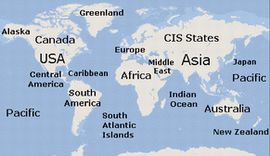|
|
|
|
Travel in India |
|
|
|
|
How to get to and from hundreds of the world's airports by car, bus, train and other forms of public transport. |
Updates and requests for inclusion in these pages welcomed by e-mail to Steve. Information is from manysources including personal visits and may no longer be accurate. Please note I am a pilot, not a travel agent and cannot provide any travel services. Legal Disclaimer Last Update 13Jan10 |
For the first time traveller to India (and indeed for the seasoned visitor), travel in India can be daunting and confusing. There are a few thing worth noting before travelling:
Airlines & Airports: Usually only ticketed passengers are allowed into the departure and arrivals halls. For non-passengers it is often possible to buy a visitors ticket for ~INR 30-100. Guards will stand at the terminal entrance and not let anyone in without a ticket. Note: Since the terrorist attacks in Mumbai in July 2006, many terminals are not issuing tickets to visitors and are closing viewing terraces. Due to congestion at security, allow plenty of time to check in. Don't try to cut it too fine. Once sucessfully inside the terminal with your luggage, you must get your hold baggage screened at a special X-ray machine near the terminal entrance. Tell the operator which airline you are travelling with, and he will seal your bag with the appropriate tamper-proof tape. Then take your bags to the check in desk as normal. At several airports around the country, domestic flights may depart from an international terminal (usually if the flight's final destination is outside India). Make sure you check, since at the larger airports, these terminals can be a long way apart. Most airports have an air-conditioned ATM/cash machine near arrivals. There is usually a security guard nearby.
Taxis: Taxis are everywhere in India, and their drivers are always keen to gain your custom. However, although the vast majority are honest, there are some scams in operation. For this reason, I strongly recommend using the airport Pre Paid Taxi Service. Most airports have one in arrivals, and there is a man behind a desk and a large sign indicating all the prices to various destinations. These prices are fixed, so no haggling is needed, just remember that if you want an air-conditioned taxi, then you should tell them, as they are a little more expensive. You will be issued a ticket to show the driver, who will escort you to a waiting cab. At some ticket desks, you pay the man behind the desk. At others, you pay the driver. If you find your own taxi driver, either make sure he uses the meter, or agree a fare beforehand. Note that in some cities, due to inflation, a conversion factor is used for the meter. You should pay the fare on the meter multiplied by this factor. Find out from your hotel or locals what the true factor is, or if one is needed. You should not expect to pay more than about INR 10 per km. CAUTION! Avoid taking long-distance inter-city taxis at night as most tend to drive without lights and overtake on blind corners, sometimes (unsurprisingly) resulting in collisions. These dangers are reduced (but not absent) during daylight hours.
Autorickshaws: Sometimes known as tuk-tuks, these are 3-wheeler mini taxis and are to be found in abundance throughout most parts of India. They are much less comfortable (especially in rainy weather), have a limited baggage capacity, seat a maximum of 3 passengers, and expose you to the full force of local road pollution. However, they are cheaper than regular taxis and a lot of fun. Either make sure your driver uses the meter, or agree a fare beforehand. Note that in some cities, due to inflation, a conversion factor is used for the meter. You should pay the fare on the meter multiplied by this factor. Find out from your hotel or locals what the true factor is, or if one is needed. In some cities, there are no go areas for autorickshaws (eg Mumbai city centre and possibly some airport terminals), but by and large they can get you to most places.
Trains: Indian trains are generally very crowded, slow, hot and uncomfortable. However, in some cities (eg Mumbai or Chennai) they very often allow you to travel to the city center faster than taxis. Foreigners are usually expected to buy first class tickets, but this is still very cheap (however I suspect that many of the passengers in the first class carriages do not hold such tickets). There are carriages designated as solely for Ladies. This makes the experience for female travellers a little more pleasant, but the men must sweat it out elsewhere.
Buses: Buses are everywhere and tend to run fairly frequently. The bad news is that they are usually overcrowded, slow (even when described as Super Fast), dirty and hot. Again, they are cheap! Here, I must confess, that I have never actually used a bus in India to get to or from the airport, as the experience looks rather harrowing.
Money: ATMs and banks tend to
dispense large notes. Always try to have plenty of smaller notes (100, 50, 20 or
10 rupees) available to make life easier when it comes to paying. Taxi drivers
may pretend to have no change.
|
Europe Asia Australia Pacific New Zealand CIS/Former Soviet States Africa Canada USA Mexico Rest of Central America Caribbean South America |

|